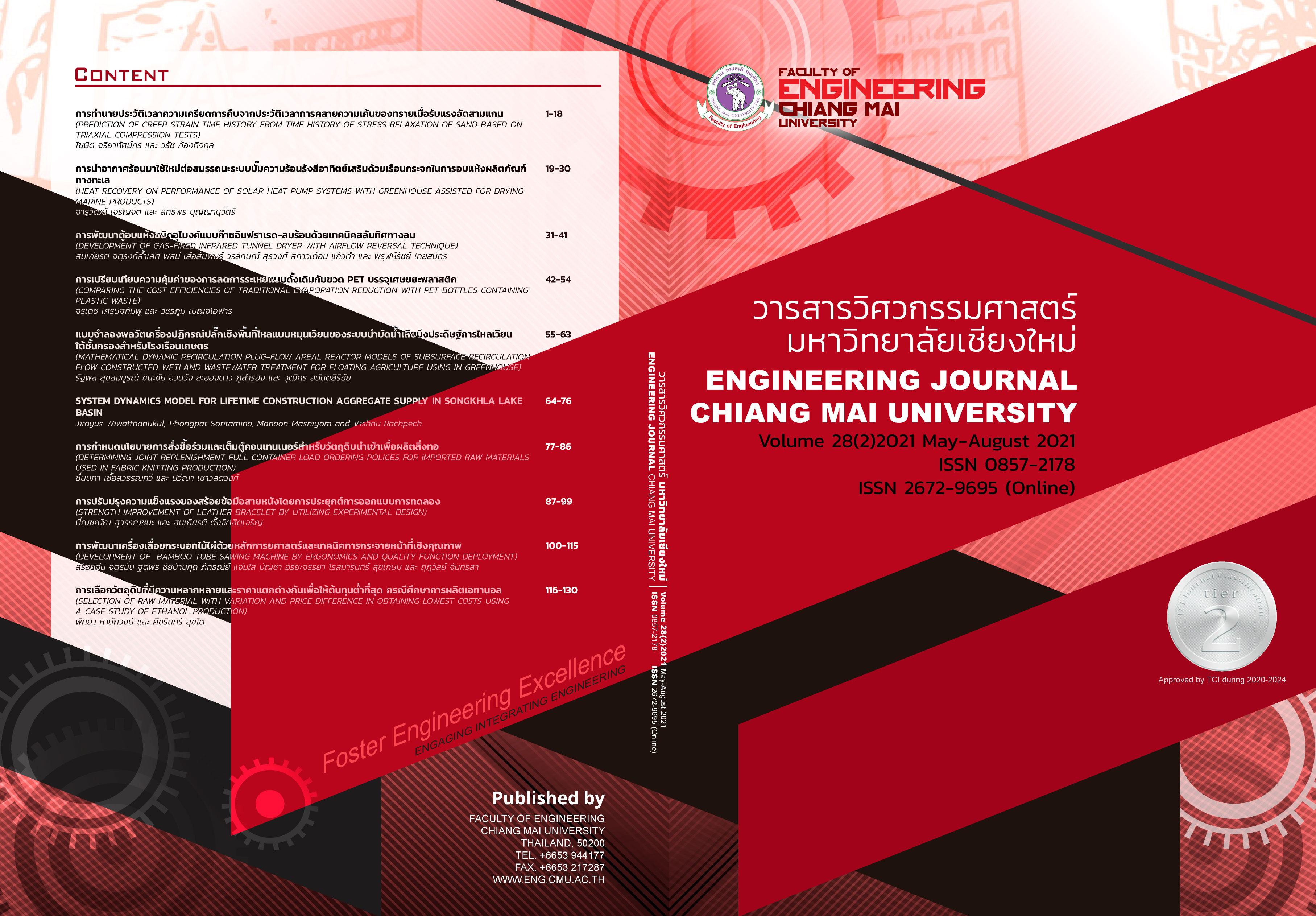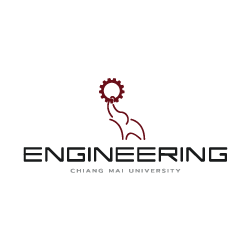Comparing the cost efficiencies of traditional evaporation reduction with PET bottles containing plastic waste
Keywords:
Reducing the evaporation rate, Recycled waste, Floating moduleAbstract
The water evaporation largely exhausted reserved water in reservoir. Three formal reduction methods of water evaporation were composed of bio-covering method, chemical and physical methods. Previous studies presented the bio-covering method can reduce the evaporation rate to 15-40% with using natural plant and rarely low expenses. But bio-covering method effected the reduction of water quality and required water quality improvement cost. The chemical method can reduce the evaporation rate to 15-30% and widely use with low expense. In the contrary, chemical method presented the B/C ratio of 1.32, the high unit cost of 7.60 Baht/m3, un-defined covering area and easily defeat by wind and fluctuated temperature. And the physical method can largely reduce the evaporation rate to 70-95% but requiring high expense and complicate installation. In this study, the physical method using PET bottles with waste plastic packed was used. These materials have lower unit cost and commercially found with further reducing waste landfill. The result presents a dramatically decreasing unit cost of 3.56 Baht/m3 and an increasing B/C ratio of 2.24. Moreover, PET bottles do not contain Diethyl hydroxylamine and Bisphenol A which has a zero environmental impact.
References
พิศ คงบริรักษ์ และกฤติกา สืบศักดิ์. (2011). การระเหยของน้ำในประเทศไทย คาบ 10 ปี (2001-2010). ใน เอกสารผลงานวิชาการอุตุนิยมวิทยา 30 กันยายน 2011 (หน้า 30-38). กรุงเทพฯ: กระทรวงเทคโนโลยีและการสื่อสาร.
ลุ่มน้ำชี. (ม.ป.ป). ปริมาณน้ำท่า. สืบค้น 22 ธันวาคม 2563, จาก https://sites.google.com/site/lumnachi/priman-natha
กีรติ ลีวัจนกุล. (2552). อุทกวิทยา (HYDROLOGY). (พิมพ์ครั้งที่ 3). ปทุมธานี: SPEC.
Penman, H.L. (1948). Natural evaporation from open water, bare soil and grass. Proc.Roy.Soc.London, A193:120-146.
ฉัตรชัย โชติษฐยางกูร. (2562). อุทกวิทยาสำหรับวิศวกร. (พิมพ์ครั้งที่ 1). ห้างหุ้นส่วนจำกัด มิตรภาพการพิมพ์ 1995: สำนักพิมพ์มหาวิทยาลัยเทคโนโลยีสุรนารี.
Helfer, F., Zhang, H., & Lemckert, C. (2010). Evaporation reduction by windbreaks: Overview, modelling and efficiency: Urban Water Security Research Alliance.
Mer, V. K. L., Aylmore, L., & Healy, T. W. (1963). The ideal surface behavior of mixed monolayers of long-chain n-paraffinic alcohols. The Journal of Physical Chemistry, 67(12), 2793-2795.
Verlee, D., & Zetland, D. (2015). Extending water supply by reducing reservoir evaporation: a case study from Wichita Falls, Texas. Proceedings of Mine Water Solutions in Extreme Environments, Vancouver, Canada.
Helfer, F. (2012). Influence of air-bubble plumes and effects of climate change on reservoir evaporation: Griffith University.
Keya, A. (2015). Solar Plant A top Irrigation Canal Impresses UN Chief. India Climate Dialogue.
Finn, N., & Barnes, S. (2007). The benefits of shade-cloth covers for potable water storages.
Álvarez, V. M., Baille, A., Martínez, J. M. M., & Real, M. M. G. (2006). Effect of black polyethylene shade covers on the evaporation rate of agricultural reservoirs. Spanish Journal of Agricultural Research(4), 280-288.
Craig, I. P. (2005). Loss of storage water due to evaporation-a literature review.
Simon, K., Shanbhag, R., & Slocum, A. (2016). Reducing evaporative water losses from irrigation ponds through the reuse of polyethylene terephthalate bottles. Journal of Irrigation and Drainage Engineering, 142(2), 06015005.
Yao, X., Zhang, H., Lemckert, C., Brook, A., & Schouten, P. (2010). Evaporation reduction by suspended and floating covers: overview, modelling and efficiency. Urban water security research alliance technical report, 28.
Elba, E. (2017). Strategies for protection and sustainable environmental management or the Highest Aswan dam in Egypt considering climate change, disserta verlag, Hamburg, page 36
Babu, P. S., Eikaas, H. S., Price, A., & Verlee, D. (2010). Reduction of evaporative losses from tropical reservoirs using an environmentally safe organic monolayer. Singapore International Water Week, Singapore.
ศูนย์ทดสอบวัสดุสัมผัสอาหารของอาเซียน กรมวิทยาศาสตร์บริการ. (2559). น้ำดื่มบรรจุขวด PET อันตรายจริงหรือไม่. สืบค้น 3 สิงหาคม 2563, จากhttp://lib3.dss.go.th/fulltext/dss_knowledge/FCM_02_2559_PET.pdf
บริษัท จัดการและพัฒนาทรัพยากรน้ำภาคตะวันออก จำกัด (มหาชน). (2562). อัตราค่าน้ำดิบของบริษัท. สืบค้นจาก https://investor.eastwater.com/th/ir-corner/faq
ภัทรานิษฐ์ ปริญญากุลเสฏฐ์. (2017). การวิเคราะห์ต้นทุนต่อหน่วยของโรงจัดการขยะแบบครบวงจร มหาวิทยาลัยเทคโนโลยีสุรนารี. Journal of Professional Routine to Research, 4, 46-55.
Downloads
Published
Issue
Section
License
ลิขสิทธิ์ของบทความที่ตีพิมพ์ในวารสารฉบับนี้จะยังเป็นของผู้แต่งและยินยอมให้สิทธิ์เผยแพร่กับทางวารสาร
การเผยแพร่ในระบบวารสารแบบเปิดนี้ บทความจะสามารถนำไปใช้ได้ฟรีในการศึกษา และในทางที่ไม่เกี่ยวกับการค้า




